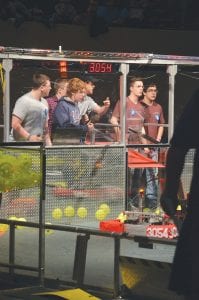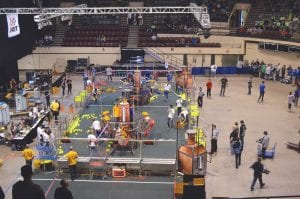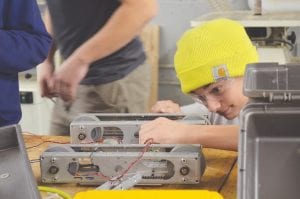The Duluth Entertainment Convention Center (DECC) was again the site for the Minnesota FIRST (For Inspiration and Recognition of Science and Technology) Regional robotics competition where 63 teams from near and far got together to vie for spots to Nationals. Unfortunately, unlike last year, Ice Storm didn’t finish in the top 24 teams and make the finals on Saturday afternoon.
The competition was held March 2-4.
Still, despite running into problems with their ’bot, the kids from Cook County worked through the dilemmas and competed well.
Once competition began, Ice Storm had trouble traveling over the carpeting on the playing field. Too much electricity was needed to keep the wheels moving, and it killed the robot. During a break, the team switched the power from direct drive to alternate drive.
Later, the gearbox failed and the team from Irondale, Minnesota joined in to help rebuild it so Cook County could continue to compete. Despite some more problems, the kids responded, working hard to fix what wasn’t working, and kept Ice Storm going. At the end of the competition, Ice Storm finished 49th out of 63 teams.
Daniel Henry, who coached the team again this year, praised his 21-member squad who sometimes worked three to four hours after school to build their robot.
Teams have six weeks to build their robots before the competition starts.
At the start of the season, each team receives a kit of parts made up of motors, batteries, control system components, construction materials, and other automation components. Teams also receive the size of the game field and the challenges the robots will have to overcome. Following the kick-off, teams have six weeks to work with mentors to design, build, then test their robot to meet the particular engineering challenges assigned to this year’s contestants.
Robotics competitions are held worldwide. More that 83,400 high school students on 3,336 teams from around the world are competing in the Steamworks competitions this year.
The way the game works is that three schools join to fight against a three-team alliance in three-minute matches. The alliance that ends with the highest score wins. There are eight rounds, and teams rotate through the rounds ending up with other squads to form an alliance.
Each team battles by trying to shoot ping pong balls high into a stack. As the balls go into the chimney, they create “steam.” Once there is enough steam, rotors began to turn, and when there is enough pressure, robots hook up to a line and get pulled up to the airship. Points accumulate faster when rotors turn, and the most points are scored when the robots reach the top of the airships.
CCHS students who participated on this year’s team are: Connor Franks, Hannah Vander Heiden, Sam Meyer, Jack Viren, David Blackburn, Kestrel Pollock, Andy Kern, Isak Terrill, Adrian Howard- Larsen, Caleb Phillips, Lynden Blomberg, Jaden Aubid, Noah Works, John Van Heiden, Joe James, Linnea Gesch, Brooke Sherer, William Hackett, Noah Roth, JRonald Tamanaha, Gaben Henry.





Loading Comments